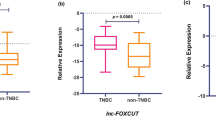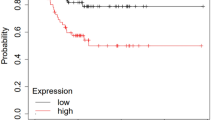Abstract
Background
Compared to other breast cancer subtypes, triple-negative breast cancer (TNBC) has always been challenging for clinicians due to its aggressive behavior and lack of a specific treatment. There is a confirmed association between invasive features of tumors and increased epithelial-mesenchymal transition (EMT) process, which is consistent with a higher rate of EMT in TNBC.
Methods and results
We investigated the expression of EMT-related genes, SNAI1 and MMP7, and EMT-related lncRNAs, treRNA and SBF2-AS1, in 50 TNBC tumors and 50 non-TNBC tumors to reveal more regulators and effectors involved in TNBC malignancy. In the present study, we showed the overexpression of all the studied genes and lncRNAs in TNBC tumors compared to non-TNBC samples. Moreover, a significant association was observed between MMP7 and treRNA expression levels and larger tumor size. A positive correlation between SNAI1 and lncRNA treRNA expression levels was also detected.
Conclusions
Due to the differential expression and the potential diagnostic power of the studied genes, SBF2-AS1 and treRNA can be proposed as new probable biomarkers and therapeutic targets in TNBC.





Similar content being viewed by others
Data Availability
The data that support the findings of this study are available from the corresponding author upon reasonable request.
References
Sung H, Ferlay J, Siegel RL, Laversanne M, Soerjomataram I, Jemal A et al (2021) Global Cancer Statistics 2020: GLOBOCAN estimates of incidence and Mortality Worldwide for 36 cancers in 185 countries. CA Cancer J Clin 71(3):209–249
Szymiczek A, Lone A, Akbari MR (2021) Molecular intrinsic versus clinical subtyping in breast cancer: a comprehensive review. Clin Genet 99:613–637
Metzger-Filho O, Tutt A, De Azambuja E, Saini KS, Viale G, Loi S et al (2012) Dissecting the heterogeneity of triple-negative breast cancer. J Clin Oncol 30:1879–1887
Yin L, Duan JJ, Bian XW, Yu SC (2020) Triple-negative breast cancer molecular subtyping and treatment progress. Vol. 22, Breast Cancer Res.
Khaled N, Bidet Y (2019) New insights into the implication of epigenetic alterations in the EMT of triple negative breast cancer. Cancers (Basel). Apr 1;11(4):559
Ribatti D, Tamma R, Annese T (2020) Epithelial-Mesenchymal Transition in Cancer: A Historical Overview. Vol. 13, Translational Oncology.
Han B, Zhou B, Qu Y, Gao B, Xu Y, Chung S et al FOXC1-induced non-canonical WNT5A-MMP7 signaling regulates invasiveness in triple-negative breast cancer. Oncogene 2018 Dec 18;37(10):1399–408
Ray T, Ryusaki T, Ray PS (2021) Therapeutically targeting cancers that overexpress FOXC1: a transcriptional driver of cell plasticity, partial EMT, and Cancer Metastasis. Vol. 11, Front Oncol.
Wang J, Li W, Zheng X, Pang X, Du G (2018) Research progress on the forkhead box C1. Vol. 9, Oncotarget. p. 12471–8
Sizemore ST, Keri RA (2012) The forkhead box transcription factor FOXC1 promotes breast cancer invasion by inducing matrix metalloprotease 7 (MMP7) expression. J Biol Chem 287(29):24631–24640
Wang S, Yan S, Zhu S, Zhao Y, Yan J, Xiao Z et al (2018) FOXF1 induces epithelial-mesenchymal transition in Colorectal Cancer Metastasis by transcriptionally activating SNAI1. Neoplasia (United States). 20(10):996–1007
Ma H, Lu L, Xia H, Xiang Q, Sun J, Xue J et al (2020) Circ0061052 regulation of FoxC1/Snail pathway via mir-515-5p is involved in the epithelial-mesenchymal transition of epithelial cells during cigarette smoke-induced airway remodeling. Sci Total Environ. ;746
Wu H, Hu Y, Liu X, Song W, Gong P, Zhang K et al (2017) LncRNA TRERNA1 function as an enhancer of SNAI1 promotes gastric Cancer Metastasis by regulating epithelial-mesenchymal transition. Mol Ther - Nucleic Acids 8:291–299
Gumireddy K, Li A, Yan J, Setoyama T, Johannes GJ, Ørom UA et al (2013) Identification of a long non-coding RNA-associated RNP complex regulating metastasis at the translational step. EMBO J 32(20):2672–2684
Yu H, Zheng J, Liu X, Xue Y, Shen S, Zhao L et al (2017) Transcription factor NFAT5 promotes glioblastoma cell-driven angiogenesis via SBF2-as1/mIR-338-3p-mediated EGFl7 expression change. Front Mol Neurosci. ;10
Wu YH, Yu B, Chen WX, Ai X, Zhang W, Dong W et al (2021) Downregulation of lncRNA SBF2-AS1 inhibits hepatocellular carcinoma proliferation and migration by regulating the miR-361-5p/TGF-p1 signaling pathway. Aging (Albany NY). 8(15):19260–19271
Wang J, Zhong P, Hua H (2021) The clinical prognostic value of lncRNA SBF2-AS1 in Cancer Patients: a Meta-analysis. Technol Cancer Res Treat. ;20
Kamaliyan Z, Mirfakhraie R, Azizi-Tabesh G, Darbeheshti F, Omranipour R, Ahmadinejad N et al (2022) The role of FOXC1/FOXCUT/DANCR axis in triple negative breast cancer: a bioinformatics and experimental approach. Mol Biol Rep 49(4):2821–2829
Zhang Y, Liao Y, Chen C, Sun W, Sun X, Liu Y et al (2020) p38-regulated FOXC1 stability is required for colorectal cancer metastasis. J Pathol 250(2):217–230
Wang D, Wang Y, Wu X, Kong X, Li J, Dong C (2020) RNF20 is critical for snail-mediated E-Cadherin repression in human breast Cancer. Front Oncol. ;10
Wang W, Shang Y, Li Y, Chen S (2019) Honokiol inhibits breast cancer cell metastasis by blocking EMT through modulation of Snail/Slug protein translation. Acta Pharmacol Sin 40(9):1219–1227
Ørom UA, Derrien T, Beringer M, Gumireddy K, Gardini A, Bussotti G et al (2010) Long noncoding RNAs with enhancer-like function in human cells. Cell 143(1):46–58
Liu R, Wang L, Gan T, Pan T, Huang J, Bai M (2019) Long noncoding RNA linc00511 promotes cell growth and invasion in triple-negative breast cancer by interacting with snail. Cancer Manag Res 11:5691–5699
Tian Y, Wu J, Zeng L, Zhou L, Hu Y, Pan Q et al (2021) Huaier polysaccharides suppress triple-negative breast cancer metastasis and epithelial-mesenchymal transition by inducing autophagic degradation of snail. Cell Biosci. ;11(1)
Wang W, Tang X, Qu H, He Q (2020) Translation regulatory long non-coding RNA 1 represents a potential prognostic biomarker for colorectal cancer. Oncol Lett 19(6):4077–4087
Scheau C, Badarau IA, Costache R, Caruntu C, Mihai GL, Didilescu AC et al (2019) The role of matrix metalloproteinases in the epithelial-mesenchymal transition of hepatocellular carcinoma. Anal Cell Pathol. ;2019
Lu Q, Lou J, Cai R, Han W, Pan H (2021) Emerging roles of a pivotal lncRNA SBF2-AS1 in cancers. Vol. 21, Cancer Cell Int.
Zhang YT, Li BP, Zhang B, Ma P, Wu QL, Ming L et al (2018 Oct) LncRNA SBF2-AS1 promotes hepatocellular carcinoma metastasis by regulating EMT and predicts unfavorable prognosis. Eur Rev Med Pharmacol Sci 22(19):6333–6341
Xia W, Liu Y, Cheng T, Xu T, Dong M, Hu X (2020) Down-regulated lncRNA SBF2-AS1 inhibits tumorigenesis and progression of breast cancer by sponging microRNA-143 and repressing RRS1. J Exp Clin Cancer Res. ;39(1)
Guo Y, Pan W, Liu S, Shen Z, Xu Y, Hu L (2020) ERK/MAPK signalling pathway and tumorigenesis (review). Exp Ther Med.
Xu L, Hou Y, Tu G, Chen Y, Du YE, Zhang H et al (2017) Nuclear Drosha enhances cell invasion via an EGFR-ERK1/2-MMP7 signaling pathway induced by dysregulated miRNA-622/197 and their targets LAMC2 and CD82 in gastric cancer. Cell Death Dis. Mar 2;8(3)
Ghasemi A, Hashemy SI, Aghaei M, Panjehpour M (2018) Leptin induces matrix metalloproteinase 7 expression to promote ovarian cancer cell invasion by activating ERK and JNK pathways. J Cell Biochem 119(2):2333–2344
Li Y, Liu G, Li X, Dong H, Xiao W, Lu S (2018) Long non-coding RNA SBF2-AS1 promotes hepatocellular carcinoma progression through regulation of mir-140-5p-TGFBR1 pathway. Biochem Biophys Res Commun 503(4):2826–2832
Yue CH, Chen CH, Pan YR, Chen YP, Huang FM, Lee CJ (2021) Cetyltrimethylammonium bromide disrupts mesenchymal characteristics of human tongue squamous cell carcinoma SCC4 cells through modulating canonical TGF-β/Smad/miR-181b/TIMP3 signaling pathway. Anticancer Res 41(12):6095–6104
Zeng Y, Yao X, Chen L, Yan Z, Liu J, Zhang Y et al (2016) Sphingosine-1-phosphate induced epithelial-mesenchymal transition of hepatocellular carcinoma via an MMP-7/syndecan-1/TGF-β autocrine loop. Oncotarget 7(39):63324–63337
Acknowledgements
Current research has been adopted from the PhD thesis of Ms Zeeba Kamaliyan in School of Medicine, Shahid Beheshti University of Medical Sciences and was financially supported by the “Research Department of the School of Medicine, Shahid Beheshti University of Medical Sciences” (Code 25169).
Author information
Authors and Affiliations
Contributions
ZK and RM contributed to the study conception and design. Samples collection, material preparation and data analysis were performed by ZK, GA, KD, SK, RO and NA. The first draft of the manuscript was written by ZK and KD, and finally revised by RM, NM, and VY. All the authors read and approved the final manuscript.
Corresponding author
Ethics declarations
Ethics approval
This research was conducted in compliance with the ethical principles of Helsinki Declaration and under the protocols of Ethics committee of SBMU (code: IR.SBMU.MSP.REC.1398.576).
Consent to participate
The informed consent was taken from all the patients who participated in this study.
Conflict of interests
The authors report no conflict of interests associated with this manuscript.
Additional information
Publisher’s Note
Springer Nature remains neutral with regard to jurisdictional claims in published maps and institutional affiliations.
Rights and permissions
Springer Nature or its licensor (e.g. a society or other partner) holds exclusive rights to this article under a publishing agreement with the author(s) or other rightsholder(s); author self-archiving of the accepted manuscript version of this article is solely governed by the terms of such publishing agreement and applicable law.
About this article
Cite this article
Kamaliyan, Z., Dorraji, K., Kakavand, S. et al. SBF2-AS1 and TreRNA: novel lncRNA players in triple-negative breast cancer pathogenesis. Mol Biol Rep 50, 6029–6037 (2023). https://doi.org/10.1007/s11033-023-08533-y
Received:
Accepted:
Published:
Issue Date:
DOI: https://doi.org/10.1007/s11033-023-08533-y




